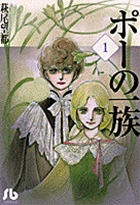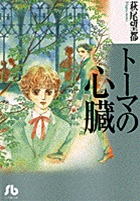AN "OFF TO THE SIDE" ARTIST
Hagio Moto is today a leading figure in Japan’s manga industry–indeed, in the country’s cultural sphere as a whole. Her oeuvre is broad and deep, with representative works including Pō no ichizoku (The Poe Clan), a depiction of beautiful vampires; Tōma no shinzō (The Heart of Thomas), about life in a boys’ boarding school in Germany; 11 nin iru! (trans. They Were Eleven), a science-fiction masterpiece; and the psychological thriller Zankoku na kami ga shihai suru (A Savage God Reigns) (all published by Shōgakukan). These have earned her many devoted readers, particularly women, who eagerly look forward to immersing themselves in the next weekly or monthly installment of her work and experiencing her delicate artistic touch, captivating characters, and thrilling dialogue.
In 2009 Hagio celebrated the fortieth anniversary of her debut as a manga artist. Her creative spark shows no sign of dimming. In this interview she gives her own views on the appeal of Japanese manga.


Pō no ichizoku, vol. 1 (L) and Tōma no shinzō, vol. 1 (R), by Hagio Moto. (Shōgakukan Bunko)
Tales of Beautiful Boys
ISOGAWA AKIKO I’ve long been a fan of your work, excitedly reading new installments as soon as they come out–something I do to this day. I recently reread a number of your manga, and one thing that jumped out at me was the fact that none of them feel dated at all.
HAGIO MOTO I’m so glad to hear you say that. I’m thankful most of all for my readers, who have read my work for so many years now.
ISOGAWA Some of your very finest series, like Pō no ichizoku and Tōma no shinzō, made their first appearances in the 1970s. At the time you were in your twenties. I remember that the girls’ manga magazines in that era were mainly filled with light-hearted romance pieces set in schools or tales of drama and hardship on the sports field. But the themes and perspectives in your work were clearly different from anything else in the field of shōjo manga, the subgenre taking adolescent girls as its audience.
HAGIO It’s hard to believe I was ever in my twenties! [Laughs] But yes, I do remember questioning the established concepts in the manga world, to some extent, as I wrote those pieces. Of course, I don’t remember precisely what I was questioning any more. [Laughs] In my work I tend to stay “off to the side,” in a manner of speaking. I don’t stick to mainstream themes like love between young men and women, or the experience of youth. This might be why I’ve been able to stick around this long as a manga creator.
ISOGAWA Young female readers were most attracted to your tales of beautiful young men, like Pō no ichizoku and Tōma no shinzō.
HAGIO At that time, homosexuality was a popular theme among the people around me. Manga artists like Takemiya Keiko and Yamagishi Ryōko were coming out with a variety of pieces along these lines. There were even regular publications like Barazoku [The Rose Clan, published by Daini Shobō] specializing in this work. But when I learned what sort of sexual acts homosexual men actually engage in, it put me off somewhat. [Laughs] Still, when I happened to see the 1964 French film Les amitiés particulières, I found it extraordinarily lovely–it had a lot in common with the world portrayed in Hermann Hesse’s writing. “Ah, if relations between boys can also feature this almost painfully naïve sentiment,” I thought, “then I’d like to write manga about them.” And so I began writing Tōma no shinzō.
ISOGAWA Many of your manga were carried in weekly or monthly publications like Shōgakukan’s Shōjo komikku [Girls’ Comic]. In those days many of the readers of these magazines–including me–were young teens. But your tales of love between boys whose voices had barely begun to change resonated with us somehow.
HAGIO I could say much the same about myself as the writer. Once I actually decided I would write a piece with love between girls as the theme, and I put together a plot, setting it in a girls’ school. But I found the stories more interesting and more enjoyable to write when I set them in a boys’ school.
ISOGAWA In 11 nin iru!–your first full-fledged science fiction work–you created a character whose sex remained undetermined until adulthood. This was a comforting thing for your young female readers–the idea of beings who were neither men nor women, who could become either.
HAGIO If you want to deal with sexual issues in your work, once you decide to express them through male and female characters, you end up bound wholly by certain preconceptions. This makes it harder to get at the heart of what you wanted to draw. When I changed the very concept of sex to free myself of this constraint, I found the expressive process became much easier. It might be illuminating to have a psychologist take a look at this phenomenon.
We tend to think of a marriage between a man and woman as the normal version of things, but I believe that in fact, love between people is a much more profound realm. We tend to be satisfied with the accepted practices that are in plain view, but I feel that there must be other worlds out there to consider.
ISOGAWA A moment ago you spoke of staying “off to the side.” Would you say that the manga medium is better suited to portraying themes that don’t get taken up by television and other mass media, or content of interest to a minority audience?
HAGIO Yes, I’d say that’s the case. When readers open up a manga collection, they only need to read the works that truly interest them. If they don’t want to read a certain work they can just turn to a different page. From the writer’s perspective, this makes things easier to create, as well.
ISOGAWA In the years since your debut, works depicting male-male romance have come under the “boys’ love” genre label. They’re now such a key part of the girls’ comic scene that they can no longer be called a minority interest. The female readers who enjoy this genre even have their own label: fujoshi, literally “rotten girls,” homophonous with a term meaning “respectable woman.” And this isn’t limited to Japan.
HAGIO A young woman from Germany once came to visit me. She told me she was a real fan of Japan’s manga–boys’ love works in particular. She’s engaged to be married and everything. I’d always thought that these homosexually themed comics would be off-limits in a Christian society, but they seem to have universal appeal to women around the world.
While on the topic of global manga fans, I’ll mention one more person–not a fujoshi in this case–who decided he wanted to go to Japan after reading Tōma no shinzō. He’s now teaching manga theory at a Japanese university.
Tezuka’s Influence
ISOGAWA Whose work, and which works in particular, influenced you as an artist?
HAGIO A number of manga creators active at the same time as me have had an impact on my work, to varying degrees. But the greatest influence has been Tezuka Osamu. It was after reading his Shinsengumi [Kōdansha] that I knew I wanted to write manga. I learned much from his work when it came to depicting human psychology and crafting a narrative. In terms of drawing technique, I’d name Ishinomori Shōtarō as an influence. His images were truly marvelous. And Mizuno Hideko–I loved the way she drew the folds in dresses! I also appreciated Chiba Tetsuya’s work, particularly the way he drew hands. His young men would wipe their cheeks with the backs of their hands–it looked fantastic. I was moved by the beauty of their exposed palms.
All these artists had their own particular area of strength, and I worked as hard as possible to steal what I could from them, copying it in my work. The general public might have seen those publications as nothing more than pulp comic magazines, but to me they were treasure troves of beauty.
ISOGAWA The protagonists in Tezuka’s Shinsengumi weren’t the famous members of the nineteenth-century band of warriors that went by that name, like Hijikata Toshizō or Okita Sōji.
HAGIO It wasn’t possible to alter the main tale of what happened to the Shinsengumi, so he shifted the focus of his work by bringing minor characters to the fore. All these little touches were fodder for my study as well. I’m also a fan of Tezuka’s Hidamari no ki [Sunlit Tree, published by Shōgakukan]. It’s set after the 1867 end of the Tokugawa shōgunate, in the rapidly changing city of Tokyo, and it’s populated with people whose vistas have suddenly opened wide, people with no problem keeping up with the pace of change, and people clinging to the world of the past. I think this is a marvelous portrayal of all these people living through an era of upheaval. It was such a complex time in history. How, I wondered, could Tezuka put it on paper in such an easy-to-understand way?
ISOGAWA So it’s important to make things easily understood?
HAGIO Yes, it’s important. Personally, I have a hard time reading Japanese novels. They’re built on so many assumptions that you have to take for granted in order to advance through their pages. The authors seem to say, “Everyone knows this, right?” but in many cases I don’t know those things. I can’t stand that feeling of needing a certain level of understanding of writers or the worlds they create in order to read their books. I don’t need to grasp all these assumptions to read foreign novels, on the other hand. I guess this is one reason I prefer writers whose prose is relatively “dry” and clear-cut. Among Japanese writers, these would include Ariyoshi Sawako and Shiba Ryōtarō. Upon first glance Tezuka’s manga seem to be rather heavy on the “wet” emotion, but in fact they fall on the dry side for the most part, and I always found them easy to read.
ISOGAWA This February the theater troupe Studio Life will bring your 11 nin iru! to the stage. As I noted a moment ago, this 1975 work was your first serious foray into science fiction.
HAGIO I put it out just after the first oil shock. It was also an era of space exploration, with various nations racking up glorious accomplishments like the successful docking of spacecraft in orbit and the sending of probes to Venus. A flood of photographs from outer space were being released, and lots of space-themed magazines were hitting the stands; I also remember observatories going up all over Japan. I was probably influenced by living in that era itself.
ISOGAWA In your manga, youngsters hoping to enter the elite Galactic University board a spacecraft for their final entrance exam. There are supposed to be just ten of them, but they suddenly realize there’s an extra person aboard. The hatch is already shut, and their test begins. These are all distinctive characters hailing from different planets throughout the galaxy. I thought the way you set up this story was absolutely thrilling.
HAGIO The motifs in that work were actually something I’d been mulling over ever since I was a high-school student, well before my debut. Northern Japan has folktales about the zashiki-warashi, a spirit that comes to dwell in a home, causing the residents to say, “Wait a minute, there’s an extra person here!” I thought it might be interesting to build a science-fiction tale around that. I also wanted to set up the story so all the characters met each other for the first time at its outset.
ISOGAWA All the characters really stand out as individuals, and you manage to frame them all within their own dramatic narratives.
HAGIO There’s a stage in the creative process where you’ve got the plot mapped out, along with the characters’ lines, and you begin putting together ideas for their faces. It’s strange, but as you draw those faces on the page you begin to perceive the stories in their backgrounds. Once their faces are fixed you see images of their mothers and fathers, their friends, the areas they come from, and even the homes they live in. I was fascinated as I drew 11 nin iru! because all these aspects of the lives of my characters came to my mind’s eye.
ISOGAWA Are there times when these images don’t come to you?
HAGIO Yes. It’s like some portion of my mind is locked away. I might actually be thinking, “I really don’t want to draw this part.” [Laughs]
ISOGAWA Your eleven cadets all come from different worlds and have different backgrounds and reasons for wanting to enter the university. They’re pressed to the very limits of their physical and mental capacity during the more than fifty days they live together, and a variety of accidents and suspicious incidents take place. At first they trade accusations with one another–“You’re the eleventh one!”–but gradually they come to a mutual understanding.
HAGIO Recently Japan has been seeing some troubled times in its relations with nearby nations. I believe that communication is the only way we can resolve these issues. We’ve got to sit down, face to face, and talk things through thoroughly. It takes time and it’s tough work, but communication is vital.
Another point to keep in mind is that all eleven of these characters put their individual talents to work in overcoming some difficulty. I feel it’s a good idea to master as many skills as possible–they could be anything at all–so you can use those abilities in life. They could be cleaning or cooking; they could be medicine or engineering. It’s important to actually put your own hands to work in cooperation with others.
ISOGAWA We’ve seen some new communication tools come out recently, like Apple’s iPad.
HAGIO I think it’s a wonderful development. I love to read manga, so I’m hoping we’ll be able to use these tools to enjoy older works soon. When you get the sudden urge to read something you haven’t gotten to yet, or a piece you remember reading long ago, you run down to the bookstore only to learn that it’s out of print, most of the time. When that happens I want to be able to sit down and read it anyway–at full size, two facing pages at once! [Laughs] It’s great that these new devices let us read large, legible print. I hope to see lots more manga become available as quickly as possible.
ISOGAWA What do you plan to work on next?
HAGIO I’ve got a few ideas, but it’s been a while since I did a science fiction story, so that’s what I’ll do first. Then maybe a historical piece, or a “costume piece” that goes heavy on the glamorous clothing.
ISOGAWA How about a sequel to Pō no ichizoku?
HAGIO That’s something I can’t say for sure, unless I get a great new idea from somewhere . . . [Laughs]
Translated from “Watashi no baai, kaku mono ga sukoshi ‘waki ni sorete’ irun desu,” Voice, February 2011, pp. 174-8. (Courtesy of PHP Institute) [February 2011]


